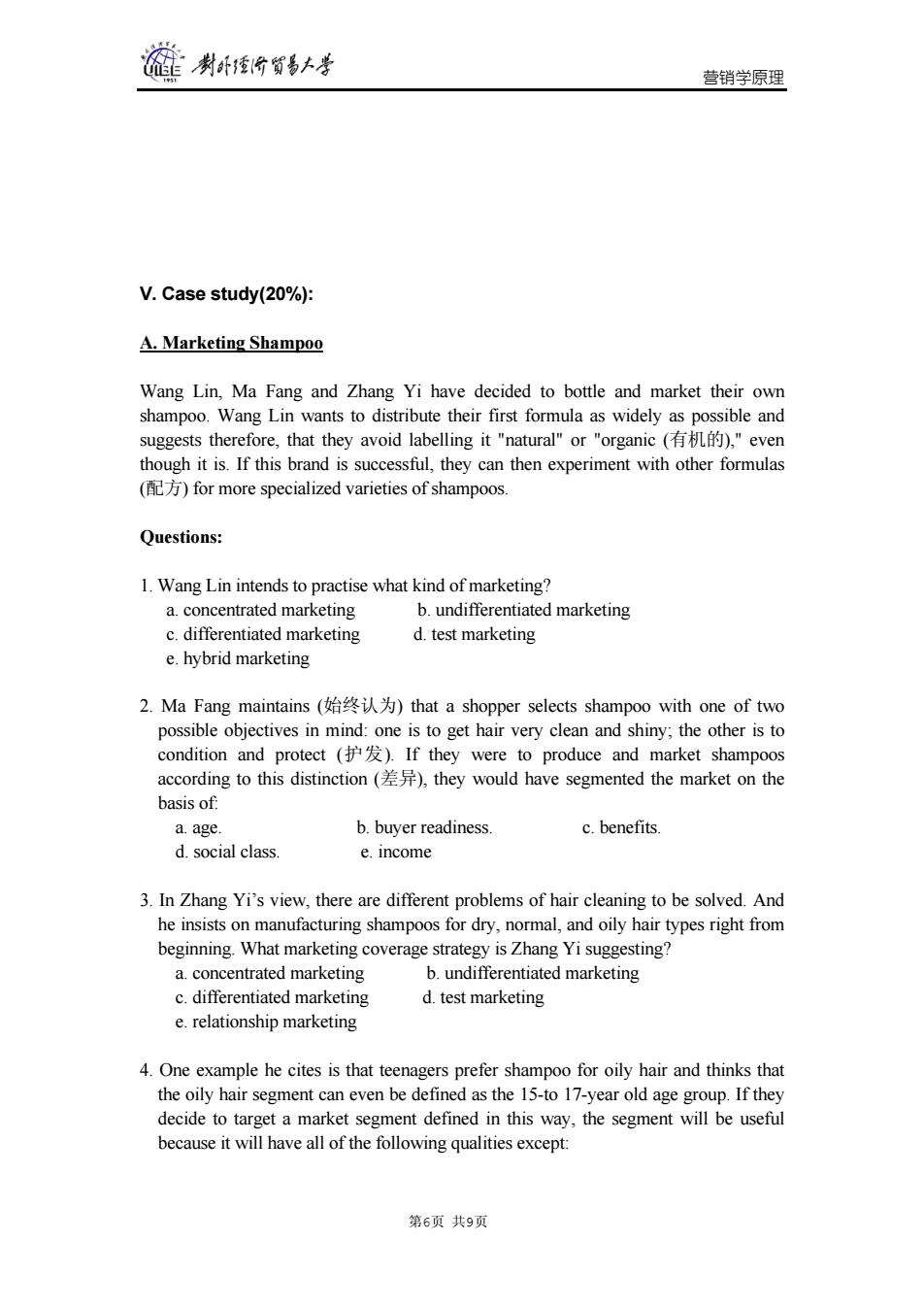正在加载图片...

滋 制卧分贸易大芳 营销学原理 V.Case study(20%): A.Marketing Shampoo Wang Lin,Ma Fang and Zhang Yi have decided to bottle and market their own shampoo.Wang Lin wants to distribute their first formula as widely as possible and suggests therefore,that they avoid labelling it"natural"or"organic(有机的),"even though it is.If this brand is successful,they can then experiment with other formulas (for more specialized varieties of shampoos. Questions: 1.Wang Lin intends to practise what kind of marketing? a.concentrated marketing b.undifferentiated marketing c.differentiated marketing d.test marketing e.hybrid marketing 2.Ma Fang maintains(始终认为)that a shopper selects shampoo with one of two possible objectives in mind:one is to get hair very clean and shiny;the other is to condition and protect ()If they were to produce and market shampoos according to this distinction ()they would have segmented the market on the basis of: a.age b.buyer readiness. c.benefits. d.social class. e.income 3.In Zhang Yi's view,there are different problems of hair cleaning to be solved.And he insists on manufacturing shampoos for dry,normal,and oily hair types right from beginning.What marketing coverage strategy is Zhang Yi suggesting? a.concentrated marketing b.undifferentiated marketing c.differentiated marketing d.test marketing e.relationship marketing 4.One example he cites is that teenagers prefer shampoo for oily hair and thinks that the oily hair segment can even be defined as the 15-to 17-year old age group.If they decide to target a market segment defined in this way,the segment will be useful because it will have all of the following qualities except: 第6页共9页营销学原理 V. Case study(20%): A. Marketing Shampoo Wang Lin, Ma Fang and Zhang Yi have decided to bottle and market their own shampoo. Wang Lin wants to distribute their first formula as widely as possible and suggests therefore, that they avoid labelling it "natural" or "organic (有机的)," even though it is. If this brand is successful, they can then experiment with other formulas (配方) for more specialized varieties of shampoos. Questions: 1. Wang Lin intends to practise what kind of marketing? a. concentrated marketing b. undifferentiated marketing c. differentiated marketing d. test marketing e. hybrid marketing 2. Ma Fang maintains (始终认为) that a shopper selects shampoo with one of two possible objectives in mind: one is to get hair very clean and shiny; the other is to condition and protect (护发). If they were to produce and market shampoos according to this distinction (差异), they would have segmented the market on the basis of: a. age. b. buyer readiness. c. benefits. d. social class. e. income 3. In Zhang Yi’s view, there are different problems of hair cleaning to be solved. And he insists on manufacturing shampoos for dry, normal, and oily hair types right from beginning. What marketing coverage strategy is Zhang Yi suggesting? a. concentrated marketing b. undifferentiated marketing c. differentiated marketing d. test marketing e. relationship marketing 4. One example he cites is that teenagers prefer shampoo for oily hair and thinks that the oily hair segment can even be defined as the 15-to 17-year old age group. If they decide to target a market segment defined in this way, the segment will be useful because it will have all of the following qualities except: 第6页 共9页